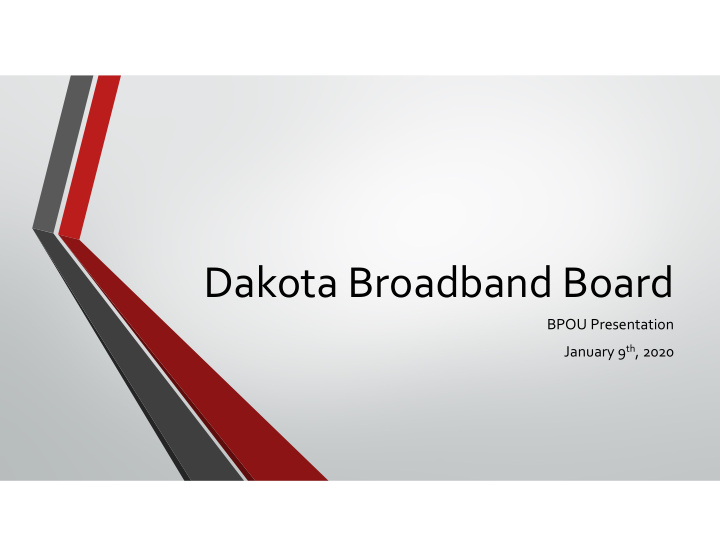



Dakota Broadband Board BPOU Presentation January 9 th , 2020
Presentation Overview 1. Introduction to Broadband 2. What is the Dakota Broadband Board (DBB)? 3. What Value Does It Bring to the Community? 4. Project Examples and Process 5. Strategic Planning and Long-term Goals 6. Questions and Conversation
Introduction to Broadband Fiber “Fiber optic technology converts electrical signals carrying data to light and sends the light through transparent glass fibers about the diameter of a human hair. Fiber transmits data at speeds far exceeding current DSL or cable modem speeds, typically by tens or even hundreds of Mbps” (FCC, 2019) Transmission speeds available using fiber are critical to technology needs today • Public safety and health care services, education, business transactions, entertainment Multiple entities can utilize fiber in a single conduit through the addition of electronics and switches to guide the signals Dakota County “ Dig Once” Initiative • Opportunity to reduce the cost of fiber installation through collaboration/planning
What is the DBB? • Joint Powers Organization between 10 cities in Dakota County, Dakota County, and the Dakota County Community Development Agency • Member Cities: Apple Valley, Burnsville, Farmington, Hastings, Inver Grove Heights, Lakeville, Mendota Heights, Rosemount, South St Paul, and West St Paul • Created in December 2017 • DBB Purpose • To create a high performance institutional network (I-Net) for the efficient management of physical network assets owned among members (conduit, fiber cable, etc.), and to enable more efficient and lower cost price agreements for members for a variety of IP-based services • To utilize excess I-Net capacity to enhance business attraction, business retention and economic development opportunities through the provision of wholesale access to private sector service providers (C-Net) • The DBB will not be a retail provider of services to business and residents in Dakota County
Organizational Structure • Dakota Broadband Board • One elected representative from each of the member communities • Board meetings are the 2 nd Wednesday of each month • Executive Committee • One staff member from each of the member communities • Executive Committee meeting are the 1 st Wednesday of each month • Executive Director • Reports to the Chair of the Executive Committee and the Chair of the Dakota Broadband Board • Contracted Services
Funding and Annual Budget 2020 Budget: $905,670 Cost per member is determine by the following factors: Total asset value in the network Number of route miles of fiber Community population Member communities also pay an annual membership/access fee
Dakota Broadband Network (2019) Through the utilization of member fiber, the DBB network connects communities across Dakota County.
Value to the Community • Improved redundancy to weather unforeseen breaks and disruptions • Expanded connections to public facilities for community services • Parks, water towers, schools, traffic signals, libraries, public safety, and core infrastructure • Efficient use of public resources through collaborative efforts and streamlined service provision • Increased potential for economic development opportunities throughout Dakota County • Enhanced capacity for Continuity of Operations (COOP) planning and disaster preparedness
State of Minnesota and Broadband Minnesota Office of Broadband Development • Connects public, private and non-profit entities with resources to improve broadband access in Minnesota Access and Speed Goals • All MN businesses and residents will have access to defined high-speed broadband upload and download speeds by 2022 • Upload and download speed goals increase for 2026 Leadership Goal for 2022 • MN will be in the top five states for broadband access
Project Examples and Process • Original Systems Plan (2017) highlighted nine “Gap” projects to be completed • Funding for fiber segments/projects is identified by individual city/county members on an annual basis • DBB members are in the process of identifying projects for 2020 • Connection of new public facilities improves service to community residents and expands network capacity and potential
Mendota Heights Project Example In Mendota Heights the Public Works building, Fire Department, and City Hall were all connected to the DBB network. Mendota Heights and its citizens benefit from these projects through: • Increased efficiency in city communication and processes • Enhanced functionality for core public infrastructure and public safety services
South St Paul Project Example In South St Paul the connection of Dakota County’s Northern Service Center to City Hall also enabled the connection of other community sites like Doug Woog Arena, the SSP Municipal Service Center, and Salem Hills Elementary. South St Paul and its citizens benefit from these projects through: • Availability of WiFi at the Community Center and Ice Arena • Expanded access and security functions throughout public buildings • Increased preparedness for potential disasters with defined backups of information.
Strategic Planning and Long-Term Goals • September 2019 Strategic Planning Session • Development of strategic objectives, performance metrics, and a multi-year strategy plan • 2020 Anticipated Outcomes and Activities • Continued engagement with existing service providers and the Minnesota Office of Broadband Development • Business plan analysis and development • Expansion of communication tools • Development and refinement of policies, procedures and processes for the organization • Completion of additional I-Net projects
Questions and Conversation Carah Koch Executive Director, Dakota Broadband Board ckoch@Farmingtonmn.gov
Recommend
More recommend